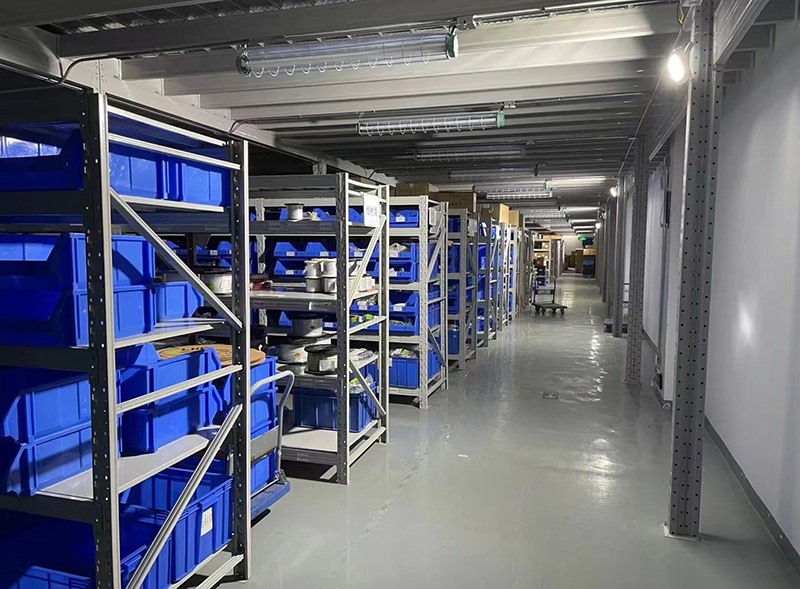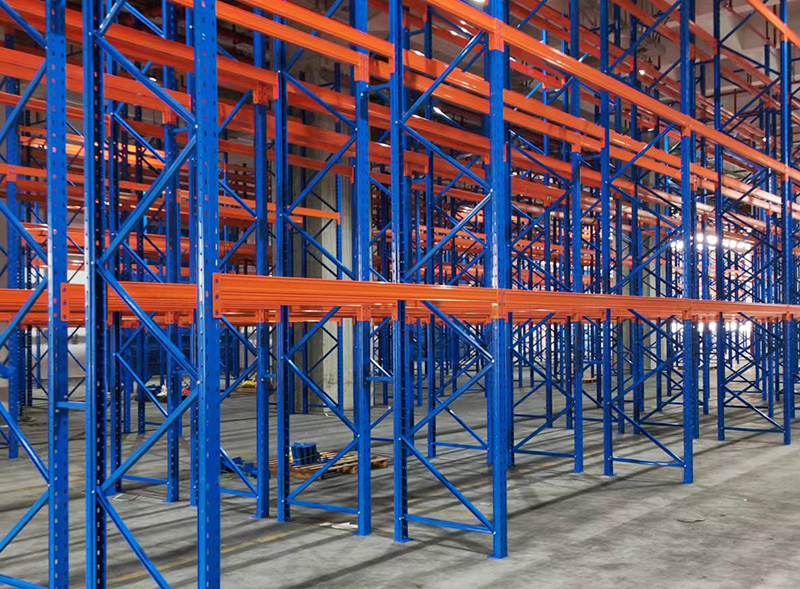In the demanding world of warehousing, manufacturing, logistics, and large-scale retail, storage solutions aren't just about holding items; they're about maximizing efficiency, ensuring safety, and enduring relentless use. Heavy duty industrial steel shelving stands as the undisputed backbone of these operations. Unlike lighter-duty alternatives, this robust storage system is engineered to handle substantial weight, resist harsh environments, and provide reliable organization for years. Understanding its core features is crucial for selecting the right system. Let's delve into the five defining characteristics that make heavy duty industrial steel shelving the go-to choice for serious storage challenges.

The very foundation of heavy duty industrial steel shelving lies in its construction material: high-grade steel. This isn't flimsy sheet metal; it's typically thick-gauge (often 12-gauge, 14-gauge, or 16-gauge) steel known for its exceptional strength-to-weight ratio and inherent durability.
Robust Frame Construction: Uprights (vertical posts) are usually constructed from heavy-duty C-channel or tubular steel. These profiles provide immense vertical load-bearing capacity and resist bending or buckling, even under uneven loads. Cross braces, often made from similar heavy-gauge steel, triangulate the structure, adding critical rigidity and preventing rack sway. This robust framework ensures the entire unit remains stable and secure.
Durable Decking Options: Shelves (decks) are where the load directly rests. Options include:
Heavy-Gauge Wire Mesh: Offers excellent ventilation, visibility, and debris fall-through, ideal for damp environments or items needing airflow. Mesh decks on true heavy duty industrial steel shelving feature thick wires and dense grids for high point-load resistance.
Particle Board (MDF or Melamine-Faced): Provides a solid, flat surface for small items. Used in heavy duty systems, this board is significantly thicker and higher density than consumer-grade versions, often laminated for moisture and abrasion resistance. Steel supports underneath are crucial for preventing sagging.
Steel Plate: The ultimate in durability and load capacity, used for the most extreme industrial applications like storing engine blocks or heavy machinery parts.
Reinforced Joints & Connections: Components are secured using high-strength bolts, rivets, or specialized clips designed to handle vibration and constant stress without loosening. Welded joints are also common in critical areas for maximum permanence and strength.
Perhaps the most critical distinguishing factor of heavy duty industrial steel shelving is its impressive weight capacity. This isn't measured per unit, but meticulously calculated per shelf level and for the entire bay.
Per-Shelf Capacities: True heavy duty shelving typically starts at capacities of 1,000 lbs per shelf and can soar to 5,000 lbs, 10,000 lbs, or even higher for specialized configurations. This allows for the safe storage of bulky pallets, dense machinery parts, large containers of liquids, or stacks of building materials.
Total Unit/Bay Capacity: The cumulative capacity of all shelves within a single bay must also be considered, often ranging from 4,000 lbs to 40,000+ lbs. This total system integrity is vital.
Dynamic vs. Static Loads: Manufacturers specify capacities based on static loads (stationary weight). It's crucial to understand that impacts from forklifts, pallet jacks (even accidental bumps), or the dynamic forces involved in loading/unloading significantly affect the system's real-world tolerance. Heavy duty industrial steel shelving is designed with a significant safety factor to accommodate these realities better than lighter systems.
Uniform vs. Concentrated Loads: Specifications often distinguish between uniformly distributed loads (weight spread evenly across the shelf) and concentrated loads (weight focused on a smaller area, like pallet feet). Heavy duty shelving excels at handling demanding concentrated loads common with palletized goods.
Despite its ruggedness, heavy duty industrial steel shelving offers remarkable flexibility to adapt to diverse spatial and storage needs.
Adjustable Shelving: The hallmark of versatility. Shelves can be repositioned vertically at incremental intervals (usually 1" or 2") along the uprights using clips, pins, or bolts. This allows you to customize shelf heights to accommodate items of vastly different sizes – from small boxes to tall drums – within the same unit, maximizing vertical space utilization.
Modularity & Expandability: Systems are designed to be modular. You can start with a single bay and easily add more bays side-by-side or back-to-back to create long runs of shelving. This scalability makes heavy duty industrial steel shelving a cost-effective long-term investment as storage needs grow.
Bay Size Variations: Standard widths (e.g., 36", 42", 48", 60") and depths (e.g., 24", 36", 42", 48") are common, allowing customization to fit specific aisle widths and storage item dimensions. Heights can range from 6 feet to over 20 feet, often leveraging the strength of steel for safe multi-tiered storage.
Accessory Integration: True heavy duty systems support a wide range of accessories:
Dividers & Bin Rails: Organize smaller items on shelves.
End & Back Panels: Contain small items and add rigidity.
Wire Deck Kits: Convert solid shelves to wire for specific sections.
Cantilever Arms: For storing long, awkward items like lumber or piping (often used with specialized heavy-duty cantilever racks, but some shelving integrates similar concepts).
Security Doors: Add lockable mesh doors for valuable or hazardous items.
Label Holders & Signage: Essential for inventory control.

Heavy duty industrial steel shelving is built to withstand the punishing conditions of industrial and warehouse environments, offering a significantly longer lifespan than lighter alternatives.
Resistance to Impact & Abuse: The thick-gauge steel construction inherently resists dents, bends, and deformation from accidental forklift impacts, dropped items, or rough handling – common occurrences in busy warehouses. Reinforced corners and edges add further protection.
Corrosion Protection: Exposure to moisture, chemicals, or temperature variations can cause rust. High-quality heavy duty industrial steel shelving employs advanced protective finishes:
Powder Coating: A dry electrostatically applied paint cured under heat, providing a thick, durable, and chip-resistant barrier in various colors. Offers excellent general protection.
Epoxy Coating: Often used for even higher chemical resistance, common in food processing, pharmaceutical, or chemical storage settings.
Galvanization (Pre- or Post-Fabrication): Applying a zinc coating provides sacrificial protection, particularly effective against rust in harsh environments. Common for wire mesh components.
Fire Resistance: Steel is non-combustible, offering a significant safety advantage over plastic shelving in case of fire, helping to contain damage and prevent structural collapse.
Minimal Maintenance: Unlike wood that can rot or warp, or lighter steel that bends easily, properly finished heavy duty industrial steel shelving requires minimal upkeep – primarily periodic cleaning and visual inspection for damage or overload. Its resilience translates to lower total cost of ownership over decades.
Safety is paramount in industrial settings. Heavy duty industrial steel shelving incorporates design elements specifically aimed at protecting workers, inventory, and the facility itself.
Inherent Stability: The robust C-channel or tubular uprights, combined with cross-bracing and secure bolted/welded connections, create an exceptionally stable structure resistant to tipping or collapse when properly installed and loaded.
Load Capacity Clarity: Reputable manufacturers provide clear and detailed load capacity ratings for each shelf level and the entire bay. Adhering strictly to these ratings is the single most important safety practice. Heavy duty industrial steel shelving is designed with significant safety factors built-in, but exceeding rated capacities is dangerous.
Secure Decking: Heavy-gauge wire mesh or reinforced particle board decks are securely locked into place, preventing accidental dislodgement. Steel lips or end stops on decks prevent items from sliding off.
Safe Installation & Anchoring: Proper installation is critical. Units must be assembled correctly on a level floor. Anchoring heavy duty industrial steel shelving to the concrete floor (using seismic anchors where applicable) is often mandatory, especially for tall units or in seismic zones, preventing movement or tipping.
Compliance with Standards: High-quality heavy duty industrial steel shelving is often designed and tested to meet or exceed relevant industry standards (like ANSI MH16.1 in the US or similar international standards), ensuring structural integrity and safety protocols are followed.
Visibility: Wire mesh decks offer excellent visibility of stock, reducing the need for excessive reaching or bending and aiding in inventory checks. Open designs also improve airflow around stored goods.
Choosing and Implementing Heavy Duty Industrial Steel Shelving
Selecting the right heavy duty industrial steel shelving involves careful consideration:
Assess Your Loads: Accurately determine the maximum weight per shelf and the nature of the loads (uniform, concentrated, palletized). Always choose a system with rated capacities exceeding your maximum anticipated load.
Measure Your Space: Consider floor dimensions, ceiling height, aisle widths needed for access (e.g., forklifts, pallet jacks), and door clearances. Factor in future expansion.
Evaluate Environmental Factors: Will the shelving be exposed to moisture, chemicals, extreme temperatures, or washdowns? This dictates the necessary corrosion protection (powder coat type, epoxy, galvanization).
Determine Access Needs: How will items be placed and retrieved? Manual access requires different aisle widths than forklift access. Consider shelf adjustability frequency.
Prioritize Safety & Compliance: Ensure the system meets local building and safety codes. Budget for professional installation and mandatory anchoring. Plan for clear load labels on every shelf level.
Source Reputable Suppliers: Choose manufacturers and suppliers known for quality materials, clear engineering specifications, and adherence to standards. Don't compromise on steel gauge or finish quality for critical heavy duty applications.
Heavy duty industrial steel shelving is far more than simple storage; it's a fundamental infrastructure investment for any operation dealing with substantial weight, demanding environments, and the need for efficient, safe organization. Its unparalleled strength derived from heavy-gauge steel, exceptional weight-bearing capacities, adaptable design, long-term durability against corrosion and impact, and inherent safety features make it the only viable choice for serious industrial, warehouse, and large-scale commercial applications. By understanding these five core features – structural integrity, load capacity, versatility, durability, and safety – you can make an informed decision that enhances operational efficiency, protects your valuable inventory, safeguards your workforce, and delivers reliable performance for decades. When your storage demands are heavy, there's no substitute for the proven resilience and capability of true heavy duty industrial steel shelving.
 Wechat
Wechat
 Whatsapp
Whatsapp